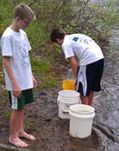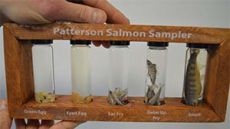As East Grand Rapids Middle School eighth-grade students walked into science class, many took a moment to peer into a specialized fish tank. Salmon eggs inside had recently transformed into eleven, newly hatched fish still attached to their egg sacs.
Day after day, students in teacher Kevin Vance’s seventh- and eighth-grade science classes witness the morphing of Chinook salmon on their way to developing into full-grown fish.
Students will release the young salmon in the fry stage come May. To give the sensitive fish the best odds of surviving until spring, students are working alongside Vance to monitor the progress of the fish and change and check water quality in the tank daily. Once egg sacs are absorbed, they will feed the fish, too.
“It’s cool how they progress through the days,” said Cooper Bell, an eighth-grade student. “I didn’t know how many eggs they hatch.”
 Salmon in the Classroom
Salmon in the Classroom
Vance is taking part in the Michigan Department of Natural Resources’ program Salmon in the Classroom, an educational outreach program that allows students to raise, care and maintain salmon from fall to spring. The special tank, which costs about $1,000, is funded by Schrem’s West Michigan Trout Unlimited, an organization dedicated to the conservation, protection and restoration of North America’s trout and salmon and their watersheds.
The project starts each November with 200 eggs from the Wolf Lake State Fish Hatchery in Mattawan. A very delicate balance involving water temperature — which must mimic river temperature during different seasons — and water quality must be maintained or fish will die, said Vance, who is leading the project for the third year.
All the fish died before release the first year, but last year, students released 59.
In the wild, only a small percent of salmon survive through the complete life cycle. “The good thing about that is it teaches that nature is a tough world, and it’s survival of the fittest,” Vance said.
 After students release salmon into the Rogue River, the fish make their way to the Grand River and then to Lake Michigan. They live for about two to three years in the lake before heading back to the river to spawn.
After students release salmon into the Rogue River, the fish make their way to the Grand River and then to Lake Michigan. They live for about two to three years in the lake before heading back to the river to spawn.
CONNECT








